 W
WAchilus flammeus, the red fungus bug, is a planthopper native to Australia, and accidentally introduced into Auckland City, New Zealand.
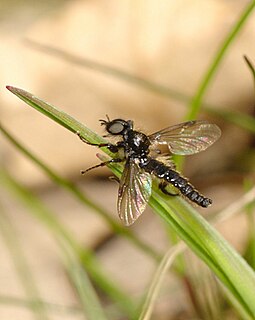 W
WBibio lanigerus is a species of fly in the family Bibionidae. It is found in the Palearctic.
 W
WBoletina trivittata is a Palearctic species of 'fungus gnat' in the family Mycetophilidae. Members of this genus are found in a wider variety of habitats from wooded streams to wetlands and open moorland. Adults have been obtained in emergence traps in a range of situations including rotting wood and soil litter.
 W
WBoreoclytocerus ocellaris is a species of fly in the family Psychodidae. It is found in the Palearctic.
 W
WBradysia praecox is a species of fly in the family Sciaridae. It is found in the Palearctic.
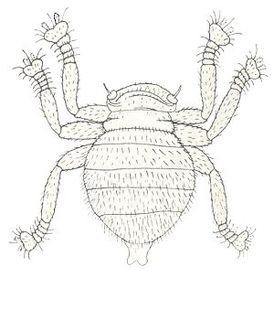 W
WBraula coeca, the bee louse, is a species of bee louse in the family Braulidae.
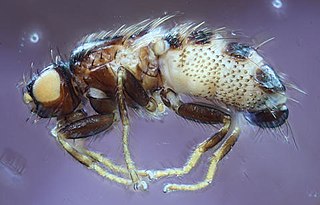 W
WCarnus hemapterus is a Dipteran insect, a small-bodied and partly black-coloured carnid fly. In their adult stage of life, they are blood-sucking ectoparasites of nestling birds. Within the genus Carnus, this is the only species widespread across Europe and the cold and temperate regions of Asia and North America. Female body length is about 1.5 mm, males are smaller. It typically occurs in the nests of medium- to large-bodied birds, provided that the nest is not on the ground. It is particularly common on the chicks of owls, falcons, rollers, bee-eaters and starlings. Females give birth to larvae that live within the nest and feed on organic debris and the pupae also overwinter there. The emergence of imagines is synchronized to the hatch of host nestlings in the subsequent year. They prefer larger chicks within the nest. Adult flies have a winged and an unwinged variety, the latter being much commoner. In fact, unwinged flies still carry the basal part of their wings, but the majority of the wing is broken off. Flies live only on the nestlings before and during the development of the plumage, and disappear later on.
 W
WCricotopus bicinctus is a species of fly in the family Chironomidae. It is found in the Palearctic.
 W
WCtenophora elegans is a true crane fly species in the genus Ctenophora. It is found in Europe.
 W
WCtenophora ornata is a true crane fly species in the genus Ctenophora.
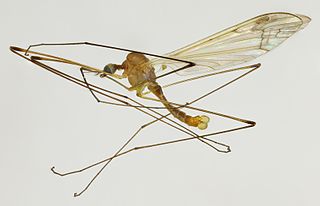 W
WDicranomyia chorea is a Palearctic species of cranefly in the family Limoniidae. It is found in a wide range of habitats and micro habitats: in earth rich in humus, in swamps and marshes, in leaf litter and in wet spots in woods.
 W
WDicranomyia modesta is a species of fly in the family Limoniidae. It is found in the Palearctic.
 W
WDiogma glabrata is a species of fly in the family Cylindrotomidae. It is found in the Palearctic.
 W
WDitomyia fasciata is a species of non-brachycera in the family Ditomyiidae.
 W
WDolerus madidus is a Palearctic species of sawfly.
 W
WDolerus picipes is a Palearctic species of sawfly.
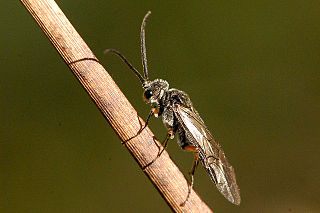 W
WDolerus vestigialis is a Palearctic species of sawfly.
 W
WEristalinus taeniops is a species of hoverfly, also known as the band-eyed drone fly.
 W
WFenusella hortulana is a Palearctic species of sawfly.
 W
WHeterarthrus microcephalus is a Palearctic species of sawfly.
 W
WMolophilus obscurus is a species of fly in the family Limoniidae. It is found in the Palearctic.
 W
WMycetophila unipunctata is a species of fungus gnats in the family Mycetophilidae.
 W
WNephrotoma scurra is a species of crane fly found in most of Europe and the East Palearctic. It should not to be confused with the crane fly Pselliophora scurra Alexander, 1941, from the subfamily Ctenophorinae.
 W
WPhaenopsectra flavipes is a species of fly in the family Chironomidae. It is found in the Palearctic.
 W
WPilaria discicollis is a species of fly in the family Limoniidae. It is found in the Palearctic.
 W
WPolistes africanus is a species of paper wasp from Senegal; Liberia; Nigeria; Cameroon; Zaire; Kenya; Somalia; Tanzania, including Zanzibar; Comoros; South Africa(Kwazulu-Natal, Western Cape Province).
 W
WPolistes major major is a Neotropical eusocial paper wasp subspecies most commonly found on the Hispaniola Island and within Central America. It has been called avispa de caballo, or "horse's wasp", in the Dominican Republic.
 W
WProdiamesa olivacea is a species of fly in the family Chironomidae. It is found in the Palearctic.
 W
WProxys punctulatus, the black stink bug, is a species of stink bug in the family Pentatomidae. It is found in the Caribbean Sea, Central America, and North America.
 W
WRhypholophus varius is a Palearctic species of craneflies in the family Limoniidae. It is found in a wide range of habitats and micro habitats: in earth rich in humus, in swamps and marshes, in leaf litter and in wet spots in woods.
 W
WSimulium variegatum is a species of fly in the family Simuliidae. It is found in the Palearctic.
 W
WThe tarnished plant bug (TPB), Lygus lineolaris, is a species of plant-feeding insect in the family Miridae. It has piercing-sucking mouthparts and has become a serious pest on small fruits and vegetables in North America. It is considered a highly polyphagous species and feeds on over half of all commercially grown crop plants, but favors cotton, alfalfa, beans, stone fruits, and conifer seedlings. A study done in southwestern Quebec, Canada has investigated the presence of L. lineolaris in a commercial vineyard. This study also indicated that weeds that grow from cultivation of crops serve as an important food source for L. lineolaris. This insect can be found across North America, from northern Canada to southern Mexico. Adults grow up to 6.5 mm in length, and are brown with accents of yellow, orange or red, with a light-colored "V" on the back (dorsal).
 W
WTasiocera murina is a species of fly in the family Limoniidae. It is found in the Palearctic.
 W
WTipula fascipennis is a species of true craneflies.
 W
WTipula obsoleta is a species of cranefly.
 W
WTipula varipennis is a species of fly in the family Tipulidae. It is found in the Palearctic.
 W
WTrichocera annulata, commonly known as the winter gnat, is a species of winter crane fly, of the order Diptera. First described by German entomologist Johann Wilhelm Meigen in 1818, it is found in Europe and North America. In North America, it is known from Alaska south to California and in Newfoundland. It is an introduced species in New Zealand.
 W
WUlomyia fuliginosa is a species of fly in the family Psychodidae. It is found in the Palearctic.